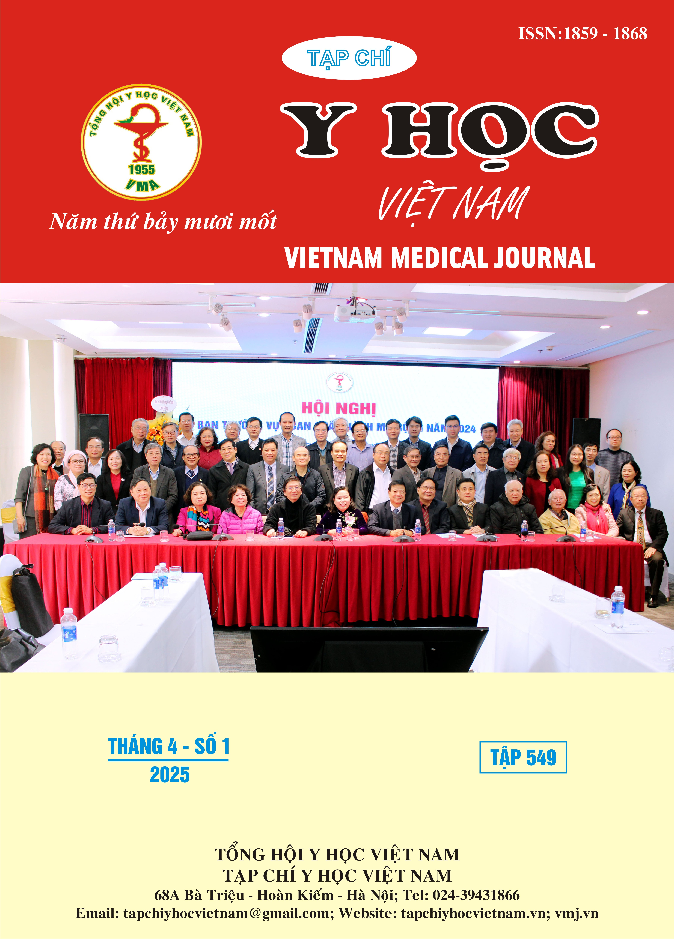THE CORRELATION BETWEEN MOUTH-OPENING LIMITATION AND MR FEATURES OF THE TEMPOROMANDIBULAR JOINT IN PATIENTS WITH INTERNAL TEMPOROMANDIBULAR JOINT DERANGEMENT
Main Article Content
Abstract
A prospective descriptive study was conducted at Hanoi Medical University Hospital from August 2023 to August 2024 on 178 patients with a total of 267 temporomandibular joints (TMJs) clinically diagnosed with internal temporomandibular joint disorder. All patients underwent an assessment of mouth-opening limitation symptoms and measurement of maximum mouth opening, followed by magnetic resonance imaging (MRI) of the TMJ. MRI abnormalities of the joints were analyzed to determine the correlation between imaging features and mouth-opening limitation symptoms. The mean age of the patient group was 25.8 ± 11.5 years, with the youngest being 11 years old and the oldest 68 years old. A significant association was found between mouth-opening limitation symptoms and abnormal disc position (p < 0.01), disc morphology changes (p = 0.015), and condylar shape (p = 0.01) on MRI.
Article Details
Keywords
Temporomandibular joint disorder, magnetic resonance imaging, limited mouth opening
References
2. Paesani D, Westesson P-L, Hatala M, Tallents RH, Kurita K. Prevalence of temporomandibular joint internal derangement in patients with craniomandibular disorders. American Journal of Orthodontics and Dentofacial Orthopedics. 1992;101(1):41-47.
3. Taşkaya-Yýlmaz N, Öğütcen-Toller M. Clinical correlation of MRI findings of internal derangements of the temporomandibular joints. British Journal of Oral and Maxillofacial Surgery. 2002;40(4):317-321.
4. Li C, Chen B, Zhang R, Zhang Q. Comparative study of clinical and MRI features of TMD patients with or without joint effusion: a retrospective study. BMC Oral Health. 2024;24(1):314.
5. Rammelsberg P, Pospiech PR, Jäger L, Duc J-MP, Böhm AO, Gernet W. Variability of disk position in asymptomatic volunteers and patients with internal derangements of the TMJ. Oral Surgery, Oral Medicine, Oral Pathology, Oral Radiology, and Endodontology. 1997;83(3):393-399.
6. Murakami S, Takahashi A, Nishiyama H, Fujishita M, Fuchihata H. Magnetic resonance evaluation of the temporomandibular joint disc position and configuration. Dentomaxillofacial Radiology. 1993;22(4):205-207.
7. Ege B, Kucuk AO, Koparal M, Koyuncu I, Gonel A. Evaluation of serum prolidase activity and oxidative stress in patients with temporomandibular joint internal derangement. CRANIO®. 2019;
8. Müller‐Leisse C, Augthun M, Bauer W, Roth A, Günther R. Anterior disc displacement without reduction in the temporomandibular joint: MRI and associated clinical findings. Journal of Magnetic Resonance Imaging. 1996;6(5):769-774.
9. Kumar R, Pallagatti S, Sheikh S, Mittal A, Gupta D, Gupta S. Suppl 2: M4: Correlation Between Clinical Findings of Temporomandibular Disorders and MRI Characteristics of Disc Displacement. The open dentistry journal. 2015;9:273.
10. Maizlin ZV, Nutiu N, Dent PB, et al. Displacement of the temporomandibular joint disk: correlation between clinical findings and MRI characteristics. Journal (Canadian Dental Association). 2010;76:a3-a3.


